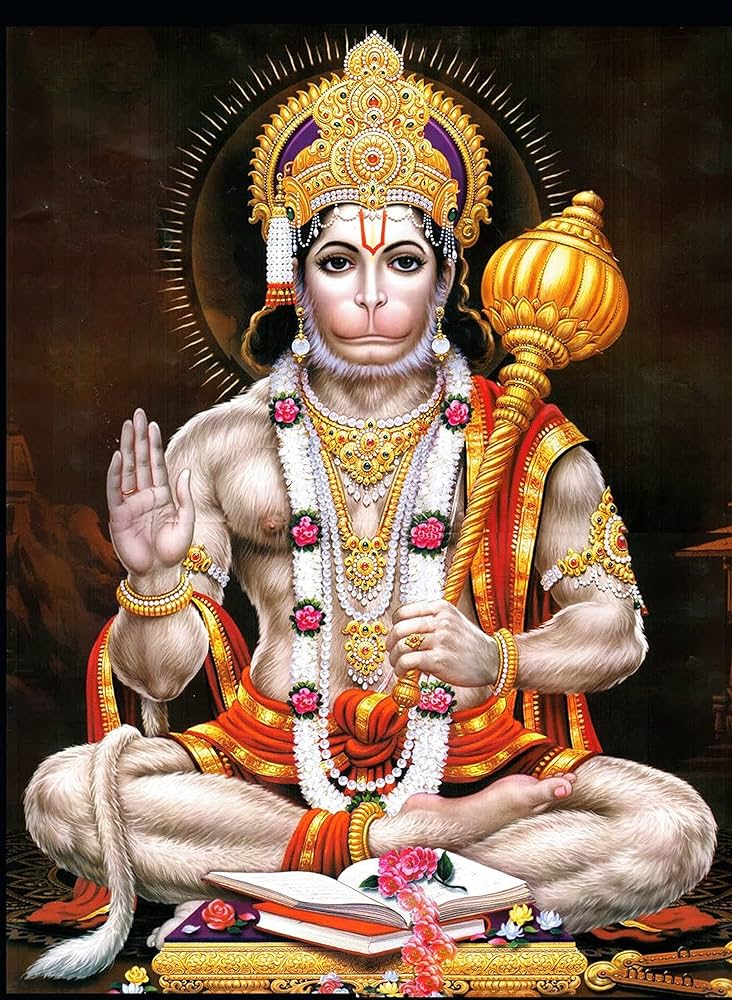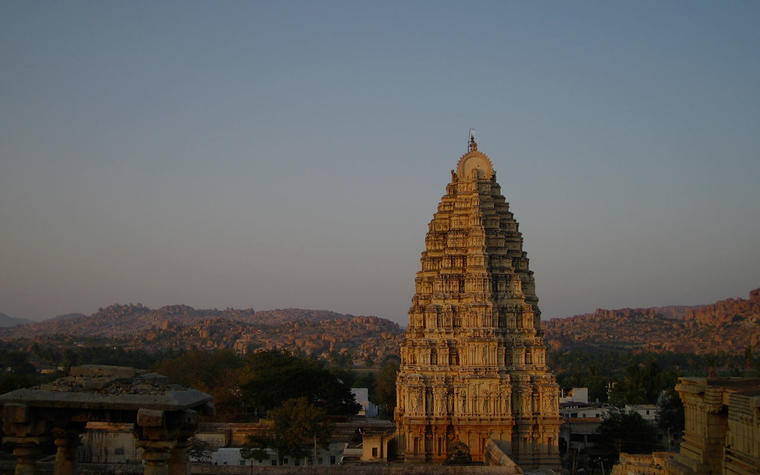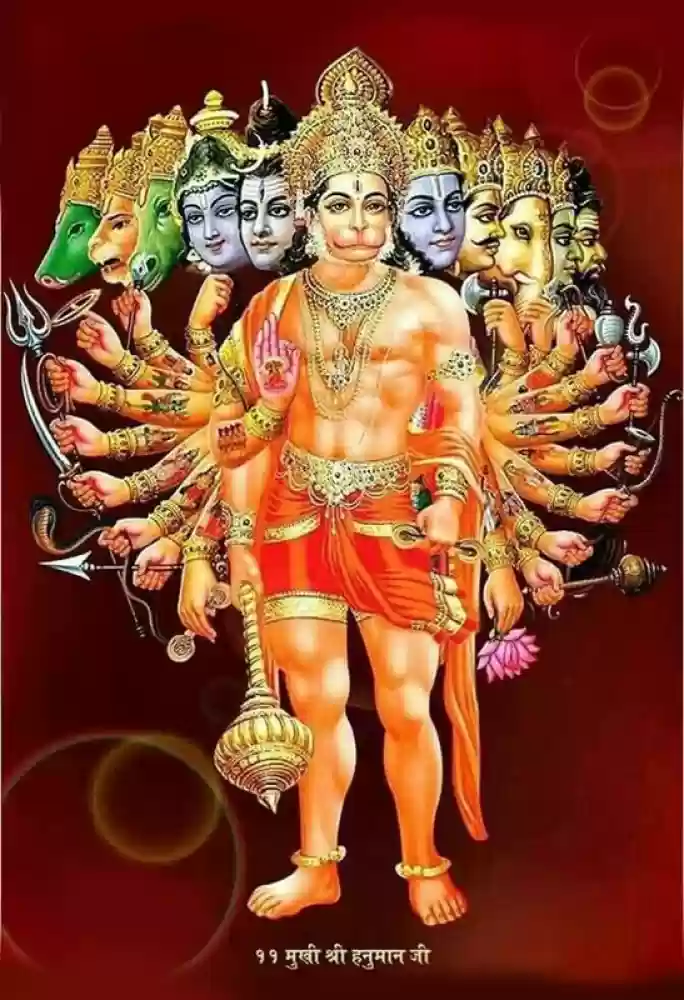Hanuman is a prominent figure in Hindu mythology and is widely revered as a devotee of Lord Rama, an incarnation of Lord Vishnu, rather than an avatar of Lord Shiva. Hanuman is known for his unwavering devotion, incredible strength, and various extraordinary abilities. He played a crucial role in the Indian epic, the Ramayana, where he assisted Lord Rama in his quest to rescue his wife Sita from the demon king Ravana.
![]()
Lord Shiva, on the other hand, is one of the principal deities in Hinduism and is considered the Destroyer within the Holy Trinity of Brahma, Vishnu, and Shiva (with Brahma as the Creator and Vishnu as the Preserver). Shiva is known for his various forms and manifestations, but Hanuman is not typically considered an avatar or incarnation of Lord Shiva in Hindu tradition.
While there are stories and legends connecting Hanuman and Shiva in some aspects, they are distinct deities with their own unique characteristics and roles in Hindu mythology. Hanuman is a symbol of devotion and unwavering loyalty, while Lord Shiva is revered for his cosmic role in the universe and his association with meditation, asceticism, and transformation.
Table of Content
Avatar Info
Hanuman, also known as Hanumanji, is a beloved and prominent figure in Hindu mythology. He is widely regarded as an incarnation of Lord Shiva and Lord Vishnu. The story of Hanuman’s birth and origin can be found in various Hindu scriptures, primarily the Ramayana and the Mahabharata.
According to the Ramayana, Hanuman is said to be the son of Anjana and Kesari, both of whom were monkeys. It is believed that Lord Shiva, one of the principal deities in Hinduism, took the form of a monkey-faced sage and blessed Anjana and Kesari with a son who possessed immense strength, wisdom, and devotion. This blessing resulted in the birth of Hanuman, who is often depicted with a monkey’s face and a strong, muscular body.

Another belief is that Hanuman is considered an incarnation of Lord Vishnu, one of the principal deities of the Hindu trinity, who takes on various avatars (incarnations) to restore dharma (righteousness) on Earth. Hanuman’s unwavering devotion and loyalty to Lord Rama, another avatar of Lord Vishnu, demonstrate his divine connection and service to the Lord. In this context, Hanuman embodies the qualities of devotion, selflessness, and loyalty that are highly revered in Hinduism.
In summary, Hanumanji is considered an incarnation of both Lord Shiva and Lord Vishnu, making him a unique and revered figure in Hinduism. His story, as depicted in the Ramayana and other Hindu scriptures, showcases his exceptional qualities, including unwavering devotion, incredible strength, and his pivotal role in the epic tale of Lord Rama’s quest to rescue his wife, Sita. Hanuman continues to be a symbol of devotion, strength, and selfless service in Hindu culture and is venerated by millions of devotees worldwide.
Incarnation
Hanuman, also known as Hanumanji, is a prominent figure in Hindu mythology and is considered a symbol of devotion, strength, and loyalty. His birth date is celebrated as Hanuman Jayanti, which varies according to the Hindu lunar calendar. Hanuman is believed to have been born on the 15th day of the bright half of the Chaitra month, which typically falls in March or April in the Gregorian calendar.
Hanuman’s birth is described in the ancient Indian epic, the Ramayana. According to the Ramayana, Hanuman was born to Anjana and Kesari, who were both monkeys. He was blessed with incredible powers by various Hindu deities, including Lord Shiva, Lord Vishnu, and Lord Brahma. These divine blessings granted him immense strength, agility, and the ability to change his form at will.

Hanuman’s life’s purpose was to serve Lord Rama, an incarnation of Lord Vishnu, and aid him in his quest to rescue his wife, Sita, from the demon king Ravana. Hanuman’s unwavering devotion and unwavering loyalty to Lord Rama made him a beloved figure in Hindu mythology.
Hanuman Jayanti is celebrated with great enthusiasm by Hindus across the world. Devotees visit temples dedicated to Hanuman, recite Hanuman Chalisa (a devotional hymn), and participate in processions to commemorate his birth. The celebrations also include devotional songs, fasting, and reading of scriptures.
Hanuman’s birth is not just a historical event in Hindu mythology but also a symbol of the power of devotion and the triumph of good over evil. His story continues to inspire millions of people to this day, emphasizing the importance of loyalty, selflessness, and dedication in one’s life.
Place of Avatar
Hanumanji, a prominent figure in Hindu mythology, is believed to have been born in a place called Anjaneri, which is situated near the city of Nashik in the state of Maharashtra, India. His birthplace is often referred to as Anjanadri Hill or Anjaneya Hill.
According to Hindu scriptures and legends, Hanuman is the son of Anjana and Kesari. Anjana was an Apsara, a celestial nymph, who was born on Earth due to a curse and later became a monkey. She and Kesari, a vanara (monkey) warrior, performed intense penance to Lord Shiva to seek his blessings for a divine child. Pleased with their devotion, Lord Shiva granted them a son, who was born on Anjaneri Hill, hence the name Anjaneya.
Anjaneri is located in the Western Ghats and is considered a sacred site in Hinduism. Devotees visit this place to pay their respects to Lord Hanuman and seek his blessings. The temple dedicated to Hanuman at Anjaneri is a popular pilgrimage site and an important part of the local religious and cultural heritage.

Hanuman is revered for his unwavering devotion to Lord Rama and his incredible strength and devotion. He played a crucial role in the epic Hindu text, the Ramayana, by helping Lord Rama rescue his wife, Sita, from the demon king Ravana.
Devotees of Hanuman often visit Anjaneri to connect with the divine energy associated with his birthplace, seeking strength, courage, and blessings. The birthplace of Hanuman, Anjaneri, remains a significant spiritual destination and a symbol of his divine presence in Hinduism.
Purpose
Hanuman, a revered figure in Hindu mythology, is believed to be the avatar of Lord Shiva and Lord Vishnu combined, with a unique purpose and significance on Earth. His avatar serves multiple profound purposes, which are deeply intertwined with the broader narrative of the Hindu epic, the Ramayana.

- Devotion and Service: Hanuman’s primary purpose is to exemplify unwavering devotion and selfless service. As a dedicated devotee of Lord Rama, he showcases the ideal bhakti (devotion) towards the divine. His entire life is a testament to his unswerving commitment to Lord Rama, whom he serves with loyalty and humility. This devotion inspires countless followers to cultivate similar dedication in their own lives.
- Role in the Ramayana: Hanuman plays a pivotal role in the Ramayana, an ancient Indian epic that narrates the life and adventures of Lord Rama. He is instrumental in finding Sita, Lord Rama’s wife, who was kidnapped by the demon king Ravana. Hanuman’s extraordinary leap across the ocean to reach Lanka, his interactions with various characters in the epic, and his pivotal role in the battle against Ravana, demonstrate the importance of his avatar in advancing the central narrative of the Ramayana.
- Symbol of Strength and Valor: Hanuman’s avatar on Earth represents immense physical and mental strength. His ability to change size, carry mountains, and perform extraordinary feats in the service of Lord Rama showcases his valor and prowess. These attributes make him a symbol of courage and determination, inspiring individuals to overcome obstacles and challenges with resilience and strength.
- Teacher of Wisdom: Hanuman’s wisdom and intelligence are also notable aspects of his avatar. He is often portrayed as a scholar and a learned being. His role as a teacher, imparting knowledge and wisdom to others, underscores the importance of learning and education in life.
- Uniting Devotees: Hanuman is revered not only by Hindus but also by people from various cultural backgrounds and faiths. His universal appeal transcends religious boundaries and unites devotees in their shared reverence for his devotion, strength, and humility.
In summary, Hanuman’s avatar on Earth serves as a multifaceted embodiment of devotion, strength, valor, wisdom, and unity. His story in the Ramayana and his teachings continue to resonate with millions of people, providing them with valuable life lessons and spiritual inspiration. Hanuman’s purpose on Earth extends beyond the boundaries of a single epic or religion, making him a revered figure with enduring significance.
Pujas for hanuman Avatar
Puja Vidhi
Lord Hanuman, the devoted and powerful deity, is worshipped by millions of devotees around the world. Hanuman is believed to be an avatar of Lord Shiva, and his puja is performed with great devotion and reverence. Here is a concise puja vidhi (ritual) for Hanumanji’s avatar:
Sankalp (Setting an Intention): Begin the puja by setting a sankalp, which is a sacred intention. Sit in a quiet, clean space and focus your mind on your purpose for the puja.
Preparation: Ensure that you have a clean and tidy place for the puja. Place a picture or idol of Hanumanji in the puja area. Light a diya (lamp) using ghee or oil.
Offerings: Prepare offerings for Hanumanji. These typically include flowers, fruits, sweets like laddu, incense sticks, and betel leaves.
Recitation of Mantras: Chant Hanuman Chalisa or other Hanuman mantras. The Hanuman Chalisa is a 40-verse hymn dedicated to Lord Hanuman and is believed to have protective and auspicious properties.
Hanuman Aarti: Sing the Hanuman Aarti to invoke Lord Hanuman’s blessings. The aarti is a song of praise that is sung to honor the deity.
Prayer and Meditation: After the aarti, sit in meditation and offer your prayers to Lord Hanuman. You can ask for his blessings and guidance in your life, and seek his protection.
Distributing Prasadam: After the puja, distribute the prasadam (offered food) to your family members and other devotees.
Recitation of Hanuman Chalisa: Conclude the puja with another recitation of the Hanuman Chalisa.
Arti and Camphor Flame: Wave the aarti flame in a clockwise motion in front of the idol or picture of Hanumanji. It is believed to remove negative energies. Offer camphor to the deity as a symbol of purification.
Prasad: Distribute the prasad (blessed food) to all present, and partake in it as well.
Closing Prayer: Conclude the puja with a closing prayer, expressing your gratitude to Lord Hanuman for his blessings and protection.
Aarti and Bhajan: If possible, sing Hanuman bhajans (devotional songs) to conclude the puja, creating a devotional atmosphere.
This puja vidhi can be customized to your preferences and the time available to you. Remember that devotion and sincerity are key in any puja. It is also essential to perform the puja with a clean mind and heart, focusing on your faith and love for Lord Hanuman during the entire process.
Puja Time
Hanuman Jayanti, the celebration of Lord Hanuman’s birth, is a significant Hindu festival dedicated to this beloved deity. Hanuman is regarded as an avatar of Lord Shiva, and his worship holds a special place in Hinduism. While there isn’t a specific time of day associated with Hanuman’s avatar, Hanuman Jayanti is observed on different dates depending on the regional and lunar calendar variations. However, there are certain auspicious times during the day when devotees often choose to perform puja rituals to honor Lord Hanuman.
- Sunrise: Many devotees prefer to start their Hanuman Jayanti celebrations at dawn, just before or during sunrise. This time is believed to be spiritually charged, and it symbolizes the dispelling of darkness and the arrival of light. It’s an ideal time for offering prayers and performing aarti.
- Noon: Hanuman is often associated with strength and valor, and noon represents the height of the day’s energy. Performing puja and reciting Hanuman Chalisa or other Hanuman mantras during this time is considered auspicious.
- Sunset: Sunset is another auspicious time for Hanuman Jayanti puja. It signifies the conclusion of the day and is an excellent moment to offer your devotion and gratitude to Lord Hanuman.
- Evening: Many devotees choose to conduct special evening aarti and bhajan sessions dedicated to Hanuman. This is a time when families and communities come together to celebrate Hanuman Jayanti.
- Midnight: In some regions, devotees observe a midnight vigil on Hanuman Jayanti, with prayers and bhajans continuing into the early hours of the morning. This is considered a spiritually charged time for connecting with Hanuman’s divine energy.
It’s important to note that the specific time for puja may vary depending on your cultural and regional traditions. However, the key to any Hanuman Jayanti puja is devotion, sincerity, and the recitation of Hanuman Chalisa, Hanuman Ashtak, or other Hanuman mantras. Lighting a diya (lamp), offering flowers, sindoor (vermillion), and prasada (sacred food) are common customs during the puja.
Puja Benefits
Hanuman, also known as Hanumanji, is a beloved deity in Hinduism and is revered for his unwavering devotion, strength, and loyalty. Performing a puja (worship) dedicated to Lord Hanuman is believed to bring numerous benefits to the devotee. Here are some of the key puja benefits of Hanumanji:
- Strength and Courage: Hanuman is known for his immense physical and mental strength. Worshipping him can grant devotees the strength to face life’s challenges and overcome obstacles with courage and determination.
- Devotion and Surrender: Hanuman’s undying devotion to Lord Rama serves as an inspiration for devotees to develop a deep sense of devotion and surrender to the divine. Hanuman puja helps in fostering this connection.
- Protection from Negative Forces: Lord Hanuman is considered the protector from negative energies and evil spirits. His worship is believed to create a shield of protection around the devotee.
- Removal of Fear and Anxiety: Hanuman’s blessings can help alleviate fear, anxiety, and stress. He is seen as a source of strength and fearlessness, providing mental solace to his devotees.
- Health and Healing: Hanuman is often associated with good health and healing. His puja can aid in the recovery from illnesses and provide strength to those facing health issues.
- Intellectual Wisdom: Lord Hanuman is known for his intelligence and quick thinking. Worshiping him is believed to enhance one’s wisdom and intellectual capabilities.
- Success and Prosperity: Devotees seek Hanuman’s blessings for success in their endeavors, whether it be in academics, career, or personal life. He is considered the ultimate symbol of perseverance and determination.
- Fulfillment of Desires: Hanuman is often invoked to fulfill desires and wishes. His devotion to Lord Rama is a symbol of loyalty and dedication, which can inspire devotees to persevere in achieving their goals.
- Spiritual Growth: Hanuman’s puja can aid in one’s spiritual journey. His devotion and selfless service to Lord Rama exemplify the path of Bhakti (devotion) and self-realization.
- Dissolution of Ego: Hanuman’s humility and selflessness are exemplary. Worshiping him can help in reducing one’s ego and promoting a sense of humility.
- Family Harmony: Many families perform Hanuman puja to seek harmony and unity among family members, as Hanuman is considered a symbol of familial love and loyalty.
- Protection during Travel: Hanuman is often invoked for a safe journey. Devotees pray to him for protection during travel and to ensure a smooth and trouble-free journey.
In conclusion, Hanuman puja is not just a ritual but a way to connect with the divine qualities that Lord Hanuman represents. Devotees believe that through this worship, they can gain strength, courage, and the wisdom to navigate life’s challenges while fostering a deeper spiritual connection with the divine. It is essential to perform Hanuman puja with sincerity, faith, and devotion to experience the full range of benefits associated with it.

